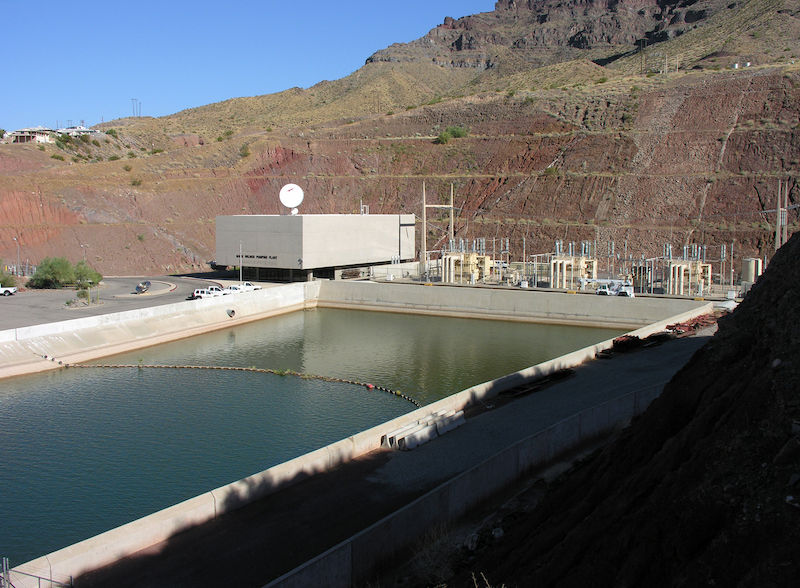By McKenna Hunter.
The Transfer
In 2018, the Town of Queen Creek, AZ was groundwater-dependent; it recognized that its complete reliance on groundwater was insufficient to allow for growth. To diversify the town’s water portfolio, part of the town’s plan included purchasing Colorado River water. As a result, the town approved a purchase from a land-owner in Cibola (GSC farm) to receive 4th priority Colorado River Water. This began a lengthy five-year legal process, culminating in an official transfer of water beginning this past July.
As part of the Phoenix Active Management Area (AMA), Queen Creek has to show that any planned development of subdivisions is consistent with the AMA’s goals—to achieve a safe yield by 2025—and plan. Thus, for any growth, the town would need to show that they are not “mining” groundwater aquifers—taking water faster than it is being replenished. Additionally, in order to subdivide under the Arizona Groundwater Management Act, any subdivision would need to show 100 years assured water supply. The Colorado River diversion allows the town to meet this requirement, while supplying over 5,000 additional homes with water, and allowing the town to work towards becoming a designated water provider by 2030.
In order to receive the 2,033 acre-feet of water from the Colorado in perpetuity, the town needed to purchase the water for $24 million and undergo a lengthy process involving the Arizona Department of Water Resources (ADWR), the Federal Bureau of Reclamation (Reclamation), and ensuing litigation.
The Process
The water involved in the Queen Creek transfer was being used to irrigate roughly 485 acres of farmland in Cibola, AZ, under a contract between the GSC farm and Reclamation. Because both the location and use of the water would be changed after the Queen Creek transfer, the transfer is subject to ADWR’s Colorado River Transfer Policy. Because of this, the ADWR held four public meetings open to verbal and written comments. After these four meetings and public comment period, ADWR made an initial recommendation to the Secretary of the Interior, David Bernhardt, in September 2020.
In the letter to Secretary Bernhardt, the ADWR laid out their evaluation for the amount of river water that would be available for transfer. The initial amount of water requested for transfer was 2,083.01 acre-feet per year for municipal use prior to weighing any negative factors, including the future use and “potential negative impacts to the water supplies of other Colorado River entitlement holders.” Notably, when the Department did weigh potential negative impacts, they concluded that there would be none. After conducting their analysis, Director Thomas Buschatzke recommended a transfer of 1,708.01 acre-feet per year to Queen Creek and recognized that the quantity could change with further information. This recommendation would allow GSC farm to retain 1,005 acre-feet per year for consumptive use.
After that recommendation, both GSC farm and Queen Creek filed subsequent documents with Reclamation to commence the transfer process. They also filed documents with the Department to propose a different value for GSC’s retention, which would allow for more water to be transferred. After reviewing the information, the Department concluded that, based on a few conditions, “it is suitable for GSC to retain 50 af/yr for consumptive uses.” As a result, Director Buschatzke sent a second letter to Reclamation in January of 2021 informing them the volume of water could be changed to as high as 2,033.01 acre-feet per year.
Following this letter, Reclamation began their own review process for the proposed action. To comply with the National Environmental Protection Act (NEPA), the Bureau conducted an Environmental Analysis. After conducting their full review process, Reclamation released a Finding of No Significant Impact (FONSI) on the human environment, and thus that there was no need for an environmental impact statement.
Ensuing Litigation
Shortly after Reclamation’s finding was released, Mohave County Board of Supervisors authorized legal action against Reclamation. Mohave was joined by La Paz and Yuma Counties and the City of Yuma, which filed a complaint in U.S. District Court in December of 2020. In their complaint, the groups sought an “order declaring that Reclamation violated [NEPA] and the Administrative Procedures Act (‘APA’)” and enjoining “Reclamation from taking any action pursuant to the transfer of contracts.” The parties worry about the environmental and economic harms that could occur by allowing a transfer of this magnitude. Rural counties often express apprehension over selling large amounts of water to growing urban centers, fearing that they will no longer have enough water for rural agricultural use.
In April, District Court Judge Michael Liburdi denied the parties’ request for a preliminary injunction. The court–in a lengthy analysis–addressed the preliminary injunction first by assessing the parties’ standing and then assessing the likelihood of the parties’ success.
The court first determined that only the Yuma Plaintiffs had shown a sufficient Injury in Fact to establish standing under the APA. Even so, because the court could identify one party having Article III standing, it could consider the merits of the plaintiff’s claims.
The court then assessed all four of the parties’ arguments that Reclamation violated NEPA and the APA. The first three arguments were for failure to consider the cumulative impacts of the transfer (1) on climate change and the ongoing drought in the Colorado River; (2) by relying on an obsolete standard dating back to 2004 which does not appreciate current drought conditions; and (3) by not analyzing the transfer’s precedent-setting nature. The parties also argued that Reclamation failed to adequately analyze the impacts of the transfer on the future growth of Queen Creek.
The court determined that all four of the parties’ arguments were “unlikely to succeed on the merits of their claim that Reclamation violated NEPA and the APA,” and it is unlikely that the parties will suffer “irreparable harm.” Accordingly, the court denied the preliminary injunction.
Conclusion
With denial of the preliminary injunction, the transfer continued as planned, and Queen Creek began receiving water from the Colorado River this past July. While Queen Creek spokesperson Constance Halonen-Wilson has said that she expects remaining steps to go smoothly, the counties and Yuma are far from finished with the dispute. The counties and Yuma hope to overturn the deal in its entirety by having the court deny Reclamation’s findings; they filed a summary judgment motion on July 21.
Arizona Attorney General Kris Mayes joined as amicus on the counties’ motion for summary judgment last month, reigniting what many thought was a done deal. The battle continues to showcase the growing divide over water rights between rural and urban communities, as urban communities in central Arizona fight for growth and rural counties fear being left behind. While later priority municipalities attempt to diversify their water portfolio and allow for growth, going to high priority agricultural communities may be a requirement. But this debate highlights the potential devastating impacts when those communities lose their water and farms begin to dry up.


McKenna is a current 2L at Arizona State Sandra Day O’Connor College of Law. He plans to go into appellate litigation and enjoys studies in Sustainability and Constitutional Law, looking at both the Federal, and State Constitutions. McKenna has had experience working at the Arizona State Supreme Court Staff Attorneys Office, and will be returning to his home state of New York working as a Summer Associate at Cadwalader, Wickersham & Taft next summer.
